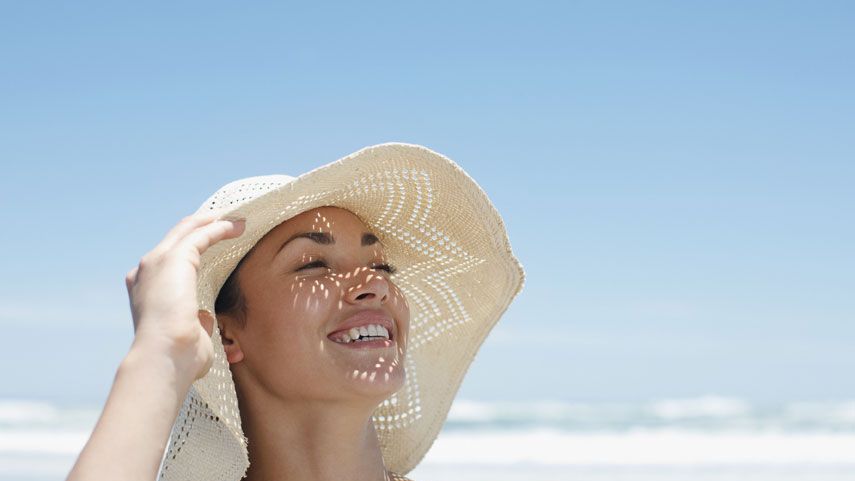Get Your Skin Ready for Summer
Summer is like a surprise houseguest: It manages to catch you unprepared every year. This season, bring it on with our head-to-toe to-do list.

Switch Your Skincare Products
More heat and humidity equal more oil and gunk on your face. Adjust your regimen accordingly. "If you use a creamy cleanser, change to a foaming face wash or even a salicylic- or glycolic-acid cleanser to remove dirt, oil, and sunscreen," says Philadelphia-based derm Dr. Susan Taylor. If you tend to break out, add a salicylic-acid toner to keep pores clear. "Swipe it over your face in the morning before applying anything else," explains Taylor. You may want to modify your moisturizer, too: "A hydrating serum may be enough moisturizer in the summer," says NYC facialist Isabelle Bellis. She also prefers face mists like Avène Thermal Spring Water because "it has a light emollient effect and counteracts the drying effects of tap water, chlorine, and salt water." And seek out ingredients like vitamins C and E or green tea. "Antioxidants neutralize free radicals from sun exposure and pollution and save your DNA from damage," says Taylor.
Exfoliate Head to Toe
"You need to exfoliate more consistently in the summer to take off sunscreen and oil," says Taylor. "Because the skin is less dry and sensitive, it's easier for most to tolerate more frequent exfoliation." With a veritable buffet of exfoliating methods — scrubs, brushes, retinoids, acids, lotions, and creams — experts suggest a bit of each. "For face, I have my patients apply a retinoid once or twice a week, then a glycolic product a couple of nights, and wash with a Clarisonic brush or a gentle scrub twice a week," says NYC dermatologist Dr. Gervaise Gerstner. "If your skin becomes dry or red, skip a night or two." For the body, Manhattan aesthetician Ildi Pekar recommends exfoliating in the shower two or three times a week using a body brush or a scrub. Taylor adds a word of warning: "Since freshly exfoliated skin is more susceptible to burning, it's critically important to use sunscreen."
Wear Sunscreen Every Day — Above and Below the Neck
"A broad-spectrum SPF 15 to 30 is fine on a regular day," says Gerstner, "but a tinted moisturizer with sunscreen doesn't count. You don't put on enough makeup to give you effective protection." (Mob Wives excluded.) Layer sunscreen under makeup that has SPF to be safe. If it's a chemical screen (with oxybenzone or avobenzone), start with clean skin, then add antiaging serums, sunscreen, moisturizer (if needed), and finally, makeup. But then you'll have to reapply the SPF (it works for about two hours before it's broken down by light), so try a translucent powder with broad-spectrum protection like Colorescience Pro Sunforgettable Brush SPF 50. And don't forget exposed shoulders, arms, décolletage, and legs, notes Taylor. "This is where sunspots and wrinkling will occur over time." But who wants to wear a sticky sunscreen all day at work? Gerstner raves about L'Oréal Paris' Sublime Sun: "It's a water-resistant broad-spectrum block but feels more like body lotion than beach sunscreen."
Smooth Bumpy Arms and Bacne
Get exclusive access to fashion and beauty trends, hot-off-the-press celebrity news, and more.
"Keratosis pilaris is the bane of every summer bride's existence," says Gerstner, referring to the goose-bumpy skin on the upper arms. "In the office, I hit it with microdermabrasion and glycolic- and lactic-acid peels." She recommends using a lactic-acid lotion, such as Lac-Hydrin, on the area daily. "Scrubbing can make KP worse." To prevent bacne, "change out of sweaty gym clothes right away," Gerstner advises, "and use an acne wash containing salicylic acid in the shower." Or consider a back facial. At Bliss Spa, it includes a hot salt scrub and a salicylic-acid peel.
Fight Fat and Cellulite Lying Down
There's nothing like the thought of getting into a bikini to motivate a gym visit. But toning up and slimming down never happens fast enough. Our advice: Jog to a professional. The Super Slimulator at Bliss Spa reduces toxin buildup and — here's the key — water retention with vacuum-suction massage. Their Fat Girl Shrink treatment uses the ionithermie technique, involving electronic stimulation, to detoxify tissue, jolt the muscles, and firm flab. Pekar, something of a cellulite whisperer, offers three different treatments at her spa that employ essential oils, electrical current, or low-level radiofrequency to eliminate toxins and water weight; shrink fat cells (and inches); smooth out dimpled skin texture; and firm arms, legs, and abs. "Vacuum-suction massage swells the skin slightly, temporarily making the surface look much more even," confirms Miami-based dermatologist Dr. Flor Mayoral. "And radiofrequency works both short- and long-term to firm the skin, and without a doubt, it helps with cellulite. The energy heats tissue deep down to stimulate collagen production and flatten fat cells. You see an immediate tightening after one treatment and will get firmer skin over time." (Best for upper legs, arms, and abdomen; $500 to $700 per treatment, recommended for six to eight sessions.)
What the new SPF Rules Really Mean
Starting this year, the FDA redefines "sunblock" as we know it. The term block will no longer be used because there's no scientific evidence that any sunscreen blocks literally 100 percent of UVA and UVB rays. New sunscreen labels can only state "broad spectrum" (which is recommended by the American Academy of Dermatology) if the product filters out UVA and UVB radiation. The buzzwords waterproof and sweat-proof will also be a thing of the past since all sunscreens eventually wear or rinse off. And forget those soaring digits: You'll see SPF 50, max. That's because an SPF 15 blocks about 93 to 95 percent of UVB rays, while an SPF 30 filters about 97 percent. Bumping your SPF above 50 doesn't make it that much more protective.